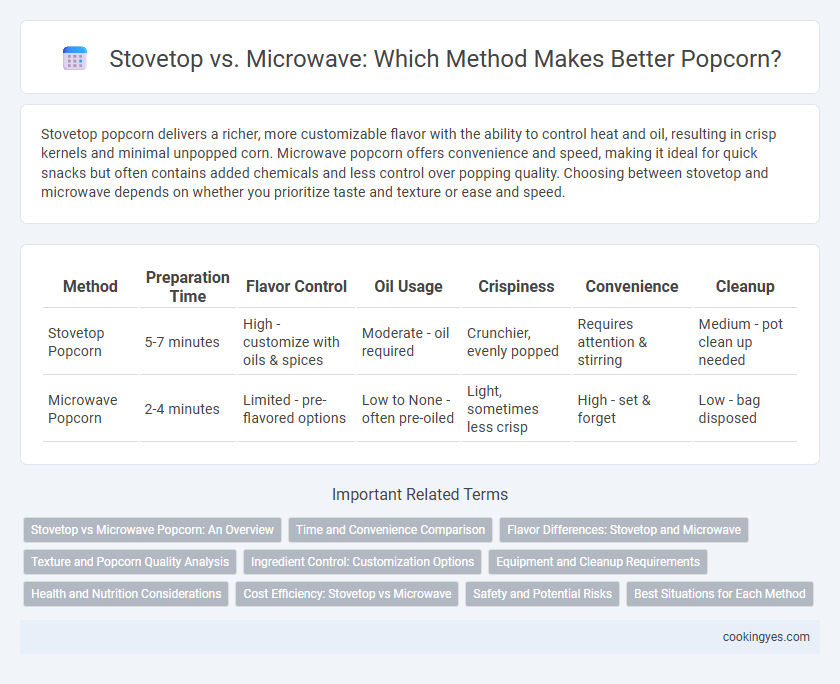Stovetop popcorn delivers a richer, more customizable flavor with the ability to control heat and oil, resulting in crisp kernels and minimal unpopped corn. Microwave popcorn offers convenience and speed, making it ideal for quick snacks but often contains added chemicals and less control over popping quality. Choosing between stovetop and microwave depends on whether you prioritize taste and texture or ease and speed.
Table of Comparison
| Method | Preparation Time | Flavor Control | Oil Usage | Crispiness | Convenience | Cleanup |
|---|---|---|---|---|---|---|
| Stovetop Popcorn | 5-7 minutes | High - customize with oils & spices | Moderate - oil required | Crunchier, evenly popped | Requires attention & stirring | Medium - pot clean up needed |
| Microwave Popcorn | 2-4 minutes | Limited - pre-flavored options | Low to None - often pre-oiled | Light, sometimes less crisp | High - set & forget | Low - bag disposed |
Stovetop vs Microwave Popcorn: An Overview
Stovetop popcorn offers control over oil quantity and flavor customization, resulting in a fresher, crispier texture compared to microwave popcorn. Microwave popcorn provides convenience and speed, utilizing pre-packaged bags with flavoring agents but often contains added preservatives and artificial ingredients. Choosing between stovetop and microwave popcorn depends on preferences for health, taste, and preparation time.
Time and Convenience Comparison
Stovetop popcorn typically takes 5 to 7 minutes to cook, offering complete control over heat and kernel texture, while microwave popcorn usually requires just 2 to 4 minutes for a faster, more convenient option. The stovetop method demands attentive stirring and monitoring to prevent burning, whereas microwave bags provide a hassle-free, set-it-and-forget-it approach ideal for quick snacks. Microwave popcorn excels in convenience and speed, but stovetop popcorn allows customization and often results in a fresher taste with fewer additives.
Flavor Differences: Stovetop and Microwave
Stovetop popcorn offers a richer, more robust flavor due to the use of fresh oil and controlled heat, which enhances the natural taste of the kernels. Microwave popcorn often contains artificial flavorings and preservatives that can result in a less authentic and sometimes chemical aftertaste. Consequently, stovetop preparation is preferred by flavor enthusiasts seeking a more natural and customizable popcorn experience.
Texture and Popcorn Quality Analysis
Stovetop popcorn offers a crispier texture and fresher flavor due to even heat distribution and oil infusion, which enhances the kernel popping process; microwave popcorn often results in softer, sometimes unevenly popped kernels with a tendency toward sogginess, influenced by pre-packaged oils and steam. Popcorn quality on the stovetop is generally superior, producing fully expanded, fluffy kernels with better control over seasoning and ingredient customization. Microwave methods prioritize convenience but can compromise on overall texture and the sensory experience of freshly popped popcorn.
Ingredient Control: Customization Options
Stovetop popcorn preparation allows for precise control over ingredients, enabling customization of oil types, salt levels, and flavor additions to suit personal preferences and dietary needs. Microwave popcorn often contains pre-measured ingredients with additives, limiting flexibility in adjusting salt, fat content, or experimenting with natural oils and spices. Choosing stovetop methods supports healthier and more tailored popcorn experiences through complete ingredient customization.
Equipment and Cleanup Requirements
Stovetop popcorn requires a pot with a lid and oil, which may need occasional stirring and oil cleanup, but the equipment is minimal and easy to wash. Microwave popcorn uses specially designed bags or reusable containers, offering a quick, less greasy option with minimal preparation but sometimes leaves residual odors in the microwave. Cleanup for stovetop popcorn includes washing pots and lids, while microwave popcorn cleanup often involves simply discarding the bag or rinsing the container.
Health and Nutrition Considerations
Stovetop popcorn preparation allows for control over the type and amount of oil used, enabling healthier choices such as heart-healthy olive or avocado oils, which contribute beneficial fats and reduce trans fat intake. Microwave popcorn often contains added preservatives, artificial flavorings, and unhealthy trans fats, which can negatively impact heart health and increase exposure to chemicals like diacetyl. Stovetop methods also avoid the risk of consuming synthetic additives, ensuring a more natural snack with potentially higher nutritional value.
Cost Efficiency: Stovetop vs Microwave
Stovetop popcorn preparation offers greater cost efficiency due to lower energy consumption and the use of affordable kernels in bulk, reducing per-serving expenses compared to microwave popcorn bags. Microwave popcorn typically involves higher ongoing costs from pre-packaged bags and specialized microwave-safe materials that increase price per portion. Investing in a stovetop popcorn maker capitalizes on reusable equipment and economical ingredients, yielding significant long-term savings.
Safety and Potential Risks
Stovetop popcorn preparation offers greater control over heat levels, reducing the risk of burnt kernels and potential smoke hazards compared to microwave methods. Microwave popcorn bags may contain chemicals like diacetyl and benzene, which pose inhalation risks and potential health concerns during cooking. Proper ventilation and choosing safer stovetop methods can minimize risks associated with popcorn preparation.
Best Situations for Each Method
Stovetop popcorn excels in situations where control over heat and oil type is desired, resulting in a customizable, crunchy texture ideal for movie nights or parties. Microwave popcorn offers unmatched convenience and speed, perfect for quick snacks or single servings with minimal cleanup. Choosing between these methods depends on whether priority lies in flavor and texture or ease and speed.
Stovetop vs Microwave for popcorn preparation Infographic

 cookingyes.com
cookingyes.com